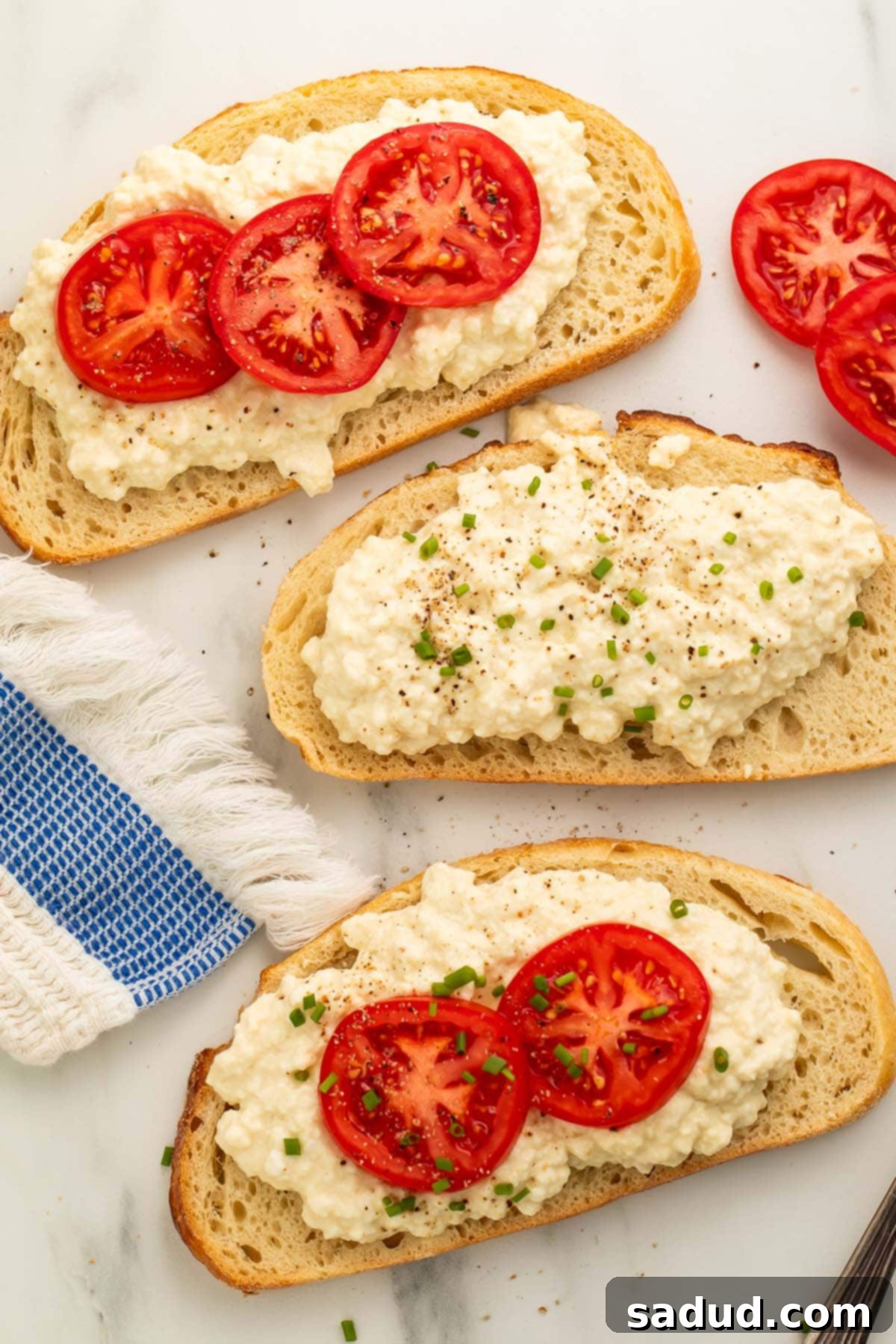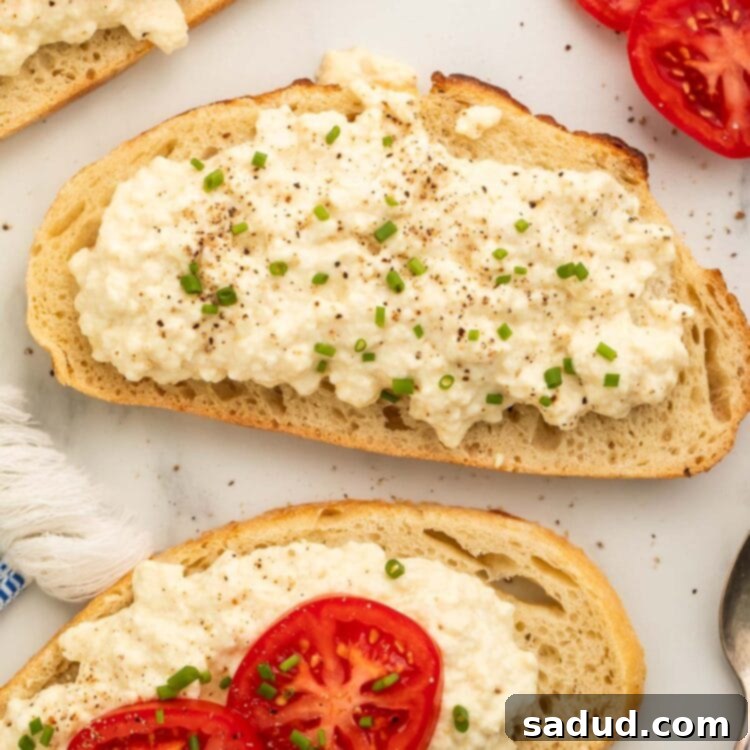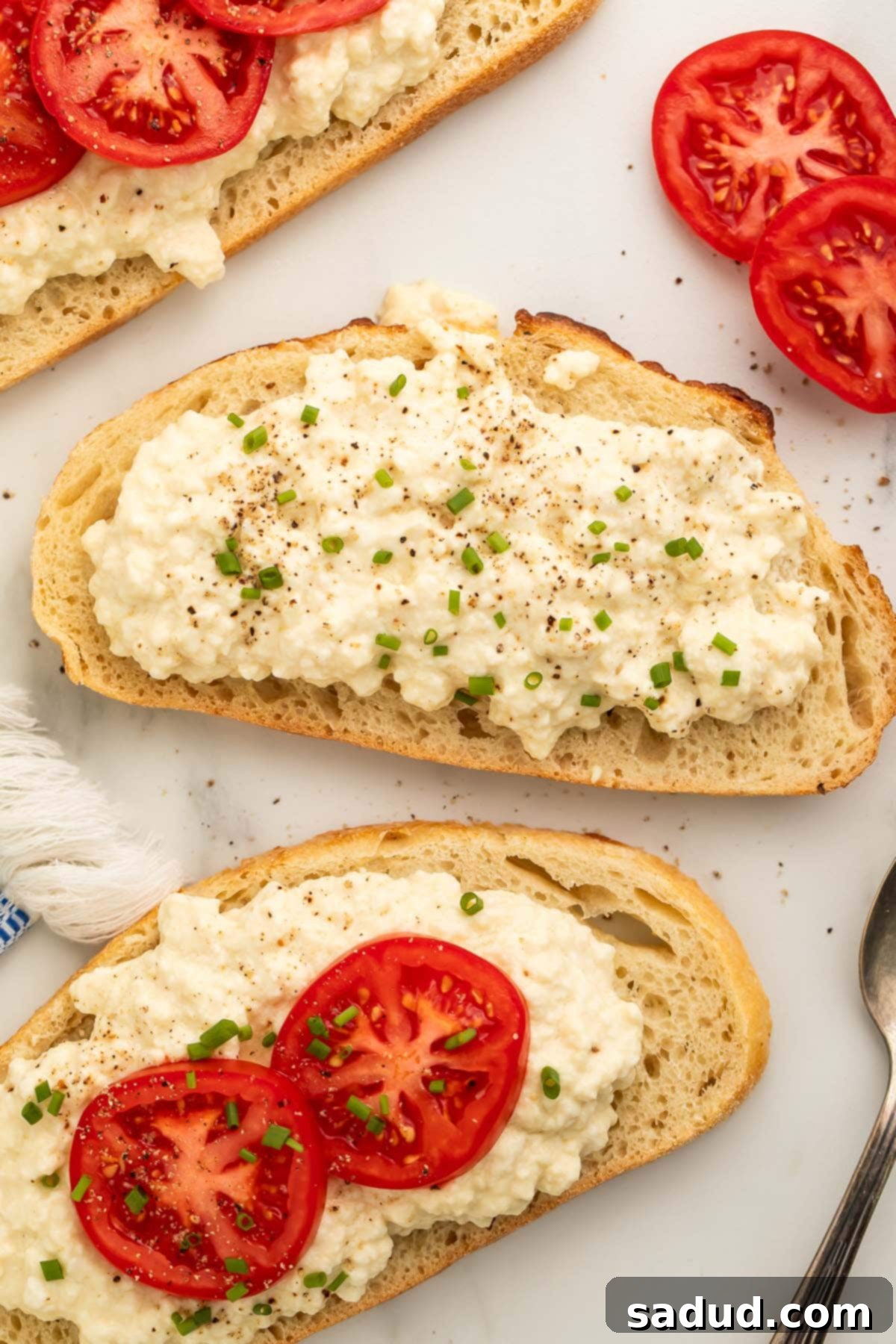Easy & Delicious Homemade Vegan Cottage Cheese: Your Go-To Dairy-Free Alternative
Discover the ultimate dairy-free delight with our incredible homemade vegan cottage cheese recipe! This plant-based marvel is a convincing, creamy, and undeniably delicious alternative to traditional cottage cheese. Crafted from simple, wholesome ingredients like silken tofu and cashews, and infused with a touch of nutritional yeast for that signature cheesy flavor, it’s a game-changer for anyone seeking a compassionate and healthier option. Whether you’re vegan, lactose intolerant, or simply looking to expand your culinary horizons, this recipe promises the perfect texture and a savory taste that will surprise and satisfy. Get ready to enjoy a guilt-free pleasure that’s remarkably easy to make and incredibly versatile!

Why You’ll Love This Dairy-Free Cottage Cheese Recipe
Our vegan cottage cheese isn’t just a substitute; it’s a stellar recipe in its own right, offering numerous benefits and delicious qualities. Here’s why this plant-based cottage cheese will quickly become a staple in your kitchen:
- Effortlessly Quick and Simple to Prepare! Forget complicated steps or lengthy cooking times. This recipe is designed for maximum flavor with minimal effort. The most time-intensive part is soaking the cashews, but even that can be dramatically sped up with our expert “Chef’s Tips” below, meaning you can whip up a batch of fresh vegan cottage cheese in just over an hour from start to finish. It’s perfect for busy weeknights or impromptu gatherings when you need a quick, healthy snack or ingredient.
- Achieves the Perfect, Authentic Cottage Cheese Texture. The magic behind this dairy-free alternative lies in its ingenious use of silken tofu. Often hailed as the softest and creamiest member of the tofu family, silken tofu is precisely what gives this recipe its characteristic crumbly, yet smooth, curds. Unlike firmer varieties, silken tofu breaks down beautifully to mimic that desirable balance – not too smooth like a spread, yet not overly chunky, creating a delightful mouthfeel that closely resembles traditional cottage cheese. Combined with creamy cashews, it’s a textural masterpiece.
- Absolutely Bursting with Delicious, Cheesy Flavor. Don’t let the “vegan” label fool you – this cottage cheese is downright delicious! A generous touch of nutritional yeast, affectionately known as ‘nooch’ in the plant-based community, is the secret ingredient that imparts a rich, cheesy, and slightly nutty flavor. This umami-packed seasoning works wonders in mimicking the savory depth of dairy, ensuring that your homemade vegan cottage cheese is incredibly satisfying and truly tastes like the “real thing.” Fresh lemon juice and apple cider vinegar add a tangy brightness, further enhancing the overall flavor profile.
- A Wholesome and Healthy Plant-Based Option. Made from whole food ingredients like tofu and cashews, this vegan cottage cheese is naturally dairy-free, cholesterol-free, and often lower in saturated fat than its traditional counterpart. It’s a fantastic source of plant-based protein from the tofu, and cashews contribute healthy fats and essential minerals. Nutritional yeast also provides B vitamins, including B12, which is often crucial for those on a vegan diet. It’s a nutritious addition to any meal, promoting a balanced diet without compromising on taste.
- Incredibly Versatile for Any Meal. Just like conventional cottage cheese, this vegan version is incredibly adaptable. Enjoy it simply spread on toast or crackers, as a high-protein addition to salads, mixed into savory bowls, or even as a creamy element in recipes. Its mild yet flavorful profile allows it to complement a wide array of dishes, making it a versatile ingredient you’ll reach for again and again.
Expert Chef’s Tips for the Best Vegan Cottage Cheese
While this recipe is designed to be straightforward, a few insider tips can elevate your homemade vegan cottage cheese to perfection and ensure a smooth cooking experience. Pay attention to these insights for optimal results:
- Speed Up the Cashew Soaking Process: If you find yourself short on time, don’t let the cashew soaking hold you back. Instead of the standard overnight soak or even a one-hour hot water soak, try this rapid method: Place your raw cashews in a small pot and cover them completely with water. Bring the water to a rolling boil, then reduce the heat, cover the pot, and let the cashews simmer gently for about 10-15 minutes. This quick boil softens them effectively, making them ready for blending in no time. Once done, drain them thoroughly, rinse under cold water, and they’re good to go for your vegan cottage cheese creation!
- Prevent Over-Soaking Your Cashews: While soaking is crucial for achieving a creamy consistency, it absolutely is possible to over-soak your cashews. If left in water for too long (typically overnight or beyond 8-12 hours in cool water, or several hours in hot water), the cashews can start to break down too much. The water might become slimy, and the cashews themselves can develop an unpleasant, slightly sour or “off” smell and taste. If this happens, unfortunately, there’s no going back – it’s best to discard them and start with a fresh batch. However, with the methods recommended in this recipe (especially the quick boil or the 1-hour hot water soak), over-soaking is generally not a concern. Just follow the timing, and you’ll be fine!
- Achieving the Ideal Texture: The key to authentic cottage cheese texture is in how you handle the tofu. Silken tofu is naturally soft, so a gentle pat dry with paper towels is sufficient; avoid pressing it like you would firm tofu. When crumbling, use a fork to break it into small, irregular curds. For the cashew mixture, blend it until perfectly smooth and creamy – this will form the “creamy binder” for your tofu curds. The contrast between the smooth cashew base and the chunky tofu is what makes this vegan cottage cheese so convincing.
- Customize Your Flavor Profile: While nutritional yeast provides the primary cheesy note, don’t hesitate to experiment with other seasonings. A pinch of garlic powder or onion powder can add depth. For a fresh touch, stir in some finely chopped chives or dill at the end. If you prefer a slightly tangier taste, a bit more lemon juice or apple cider vinegar can be added, always tasting as you go.
- Serving Suggestions Galore: This versatile vegan cottage cheese can be enjoyed in countless ways. Beyond spreading it on toast or crackers, consider:
- Savory Bowls: Dollop it onto grain bowls with roasted vegetables, avocado, and a sprinkle of seeds.
- Salad Topping: Add a scoop to green salads for an extra boost of protein and creamy texture.
- Stuffed Avocados or Tomatoes: Fill avocado halves or hollowed-out tomatoes for a refreshing and healthy snack.
- Dip or Spread: Serve it as a dip with fresh veggie sticks like cucumber, carrots, and bell peppers.
- On Baked Potatoes: A dairy-free alternative to sour cream or traditional cottage cheese on a warm baked potato.
- Proper Storage for Freshness: As noted in the recipe card, store any leftover vegan cottage cheese in an airtight container in the refrigerator. It will maintain its best quality for up to 3 days. Beyond that, the texture and flavor might start to diminish. Freezing is generally not recommended for cottage cheese (dairy or vegan) as it can alter the texture significantly upon thawing, making it watery or crumbly in an unappetious way.

More Delicious Dairy-Free & Vegan Recipes to Explore
If you’re loving the journey into plant-based eating or simply looking for more exciting dairy-free options, we’ve got you covered! Expand your culinary repertoire with these other fantastic vegan recipes:
- Hearty & Comforting Vegan Biscuits and Gravy
- Easy Vegan Tofu Cream Cheese (Discover 4 Amazing Flavors!)
- Decadent Vegan Crème Brûlée for a Sweet Treat
- How to Make Vegan Overnight Oats: 4 Creative Ways
- Classic & Creamy Vegan Cream Cheese
- The ABSOLUTE BEST Vegan Chocolate Chip Cookies You’ll Ever Make
- Spicy & Zesty Vegan Buffalo Chicken Dip
Frequently Asked Questions About Vegan Cottage Cheese
New to vegan cottage cheese or have specific questions? We’ve got answers to some of the most common queries to help you master this delicious recipe.
What exactly is vegan cottage cheese made of?
Our vegan cottage cheese is primarily made from silken tofu, which provides the distinctive “curd” texture, and raw cashews, which create the creamy, rich base. Nutritional yeast is added for a cheesy, umami flavor, while lemon juice, apple cider vinegar, and almond milk contribute to the tang and overall consistency, mimicking traditional dairy cottage cheese beautifully.
Can I use firm tofu instead of silken tofu?
While you *can* use firm or extra-firm tofu in some vegan cheese recipes, for cottage cheese, silken tofu is highly recommended and truly essential for achieving that authentic, delicate, and crumbly curd texture. Firmer tofus tend to be too dense and won’t break down in the same way, resulting in a significantly different (and less desirable) texture. If you absolutely cannot find silken tofu, you might try gently crumbling soft tofu, but expect a slightly firmer result.
Is nutritional yeast essential, or can I substitute it?
Nutritional yeast is a key ingredient for the cheesy, savory flavor in this recipe. It’s difficult to substitute directly without losing that signature taste. While you could try a small amount of white miso paste for an umami kick, it won’t provide the exact same cheesy profile. We highly recommend using nutritional yeast for the best results, and it’s readily available in most health food stores or online.
How long does homemade vegan cottage cheese last in the refrigerator?
When stored in an airtight container in the refrigerator, your homemade vegan cottage cheese will stay fresh and delicious for up to 3 days. It’s best enjoyed within this timeframe for optimal taste and texture. Always use clean utensils when serving to prevent spoilage.
Can I freeze vegan cottage cheese?
Freezing vegan cottage cheese is generally not recommended. Tofu, especially silken tofu, and cashews can change their texture significantly when frozen and then thawed. It might become watery, gritty, or lose its creamy consistency, making it less appealing. This recipe is best made fresh and enjoyed within a few days.
Is this vegan cottage cheese healthy?
Absolutely! This plant-based cottage cheese is made from whole, minimally processed ingredients. Silken tofu is an excellent source of plant-based protein, and cashews provide healthy fats and essential minerals. Nutritional yeast adds B vitamins. It’s naturally dairy-free, cholesterol-free, and offers a delicious way to enjoy a nutrient-rich, satisfying snack or meal component.
What are some creative ways to use this vegan cottage cheese?
Beyond simply eating it with a spoon or spreading it on toast, this versatile creation can be used in many ways:
- Stir it into scrambled tofu for a creamier breakfast.
- Use it as a base for a savory dip by blending in herbs like dill or chives, garlic, and a touch of onion powder.
- Layer it in a lasagna or casserole for a creamy, cheesy element.
- Mix it with fresh fruit and a drizzle of maple syrup for a sweet and savory treat (though this recipe leans savory, it can be adapted).
- Add a dollop to baked potatoes or sweet potatoes instead of sour cream.
If you loved this delightful vegan cottage cheese recipe as much as we did, don’t forget to leave us a glowing review below and share your thoughts! Your feedback means the world to us. ★ Follow Easy Healthy Recipes on Pinterest, Facebook, and Instagram, too, for more wholesome inspiration!
For even more delicious and easy-to-make recipes, be sure to visit our sister sites, 40 Aprons and Easy Cheap Recipes. Happy cooking!

Easy Vegan Cottage Cheese
 Cheryl Malik
Cheryl Malik
Print
SaveSaved!
Ingredients
For Soaking the Cashews
- 1 cup water (for boiling to soak cashews)
- 3 tablespoons raw cashews (ensure they are raw, not roasted or salted)
For the Tofu Curds
- 10 ounces silken tofu (softest variety, crucial for cottage cheese texture)
For the Creamy Vegan Cottage Cheese Mixture
- 1 ½ tablespoons nutritional yeast (for that irresistible cheesy flavor)
- 2 tablespoons lemon juice (freshly squeezed for best tang)
- 3 tablespoons unsweetened almond milk (or other unsweetened plant-based milk)
- 1 teaspoon apple cider vinegar (adds a lovely tang)
- salt to taste (start with a pinch and adjust)
- freshly cracked black pepper to taste (enhances savory notes)
Equipment
-
Small saucepan with lid for cashew soaking
-
Colander for draining cashews
-
Paper towels for drying tofu
-
Medium mixing bowl for tofu and combining
-
Fork for crumbling tofu
-
Food processor essential for a smooth cashew mixture
Instructions
Prepare the Cashews
-
To begin, add 1 cup of water to a small saucepan. Place the saucepan on your stovetop over high heat and bring the water to a rapid boil. This step is crucial for quickly softening the cashews.
-
Once the water reaches a rolling boil, immediately turn off the heat. Add the 3 tablespoons of raw cashews to the hot water and stir gently to ensure they are fully submerged. Cover the saucepan with a lid and let the cashews soak in the hot water for 1 hour. This will soften them sufficiently for blending into a smooth cream.
-
After 1 hour, carefully drain all the water from the saucepan using a colander. Rinse the soaked cashews thoroughly under cold running water, then drain them again completely. Transfer the softened cashews to the bowl of your food processor and set them aside while you prepare the tofu.
Prepare the Tofu Curds
-
Carefully remove the 10 ounces of silken tofu from its packaging. Using several sheets of paper towels, gently pat the tofu dry on all sides. You don’t need to press it heavily, just remove excess surface moisture. Place the dried tofu into a medium mixing bowl. Use a fork to gently break up the tofu until it forms small, irregular crumbles, mimicking the texture of cottage cheese curds. Ensure it’s thoroughly crumbled but not mashed into a paste. Set this bowl aside.
Assemble the Vegan Cottage Cheese
-
To the food processor bowl containing the soaked cashews, add 1 ½ tablespoons of nutritional yeast, 2 tablespoons of fresh lemon juice, 3 tablespoons of unsweetened almond milk, and 1 teaspoon of apple cider vinegar. Secure the lid tightly on your food processor and process the ingredients. Blend until the mixture is completely smooth and creamy, without any cashew lumps. This forms the delicious, cheesy, and tangy base for your cottage cheese.
-
Transfer the smooth cashew mixture from the food processor to the mixing bowl with your crumbled tofu. Season generously with salt and freshly cracked black pepper to taste. Using your fork or a spoon, gently stir and fold the ingredients together until the creamy cashew base is fully incorporated with the tofu curds, creating a texture that perfectly resembles traditional cottage cheese. Be careful not to overmix, as you want to maintain the distinct curds.
-
Your homemade vegan cottage cheese is now ready to enjoy! Serve it immediately as desired with your favorite crackers, fresh bread, sliced vegetables, or as a delightful addition to salads and savory bowls. Experience the joy of a dairy-free classic!
Notes
- Leftovers: To maintain freshness and quality, refrigerate any leftover vegan cottage cheese in an airtight container for up to 3 days. We do not recommend freezing this recipe as the texture of the tofu and cashews may become undesirable upon thawing.
- Customization: Feel free to experiment with additional seasonings! A pinch of garlic powder, onion powder, or a sprinkle of fresh chopped chives or dill can add wonderful layers of flavor to your cottage cheese.
Nutrition Information
The number of total servings shown is an approximation. The actual number of servings will vary based on your preferred portion sizes.
The nutritional values presented here are general guidelines. They reflect information for 1 serving using the ingredients listed, excluding any optional additions. Actual macros may differ slightly depending on the specific brands and types of ingredients you use.
To accurately determine the weight of one serving, prepare the recipe as instructed. Weigh the entire finished recipe (do not include the weight of the container). Then, divide the total weight of the finished recipe by your desired number of servings. The result will be the precise weight of one individual serving.
